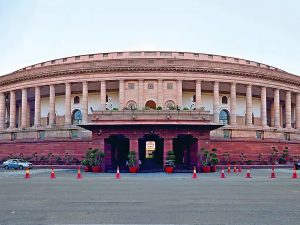
-By Sriroop Chaudhuri and Mimi Roy, Professors, Jindal School of Liberal Arts & Humanities
Stubble burning is an age-old practice in Haryana and Punjab. Official sources claim it has been curbed recently through regulations, bans, penalties and surveillance. Recent satellite imageries from Nasa’s Global Fire Mapper, however, reveal that stubble burning is no longer restricted to the rice bowl region but has spread across Madhya Pradesh, Uttar Pradesh, Chhattisgarh, Bihar and Odisha, making things even worse. Among other factors, it has been the burning of stubble in neighbouring states that has left Delhi-National Capital Region (NCR) crippled with unprecedented levels of air pollution.
Ironically, stubble burning worsens agricultural production. Burning paddy straw results in massive nutrient losses, some estimates pointing to a loss of about 1.5 lakh tonnes of nutrients annually. Such losses effectively raise expenses made for fertilisers for the following season. Straw carbon, nitrogen and sulphur are completely lost into the atmosphere when burned.
Be Chary of Charring
Burning raises topsoil temperature up to 33-42° C. This destroys all potential microbial life up to about 3 inches below the soil, besides killing life that churns the soil to release nutrients making way for water-oxygen exchange. Charring — unlike what many would believe — does not help soil fertility.
So why do farmers burn stubble then? In the days of manual harvest, stubbles were profitable as cattle feed or for use in the cardboard industry. With the introduction of combine harvesters, the crop is chopped far too short (mostly less than 40 cm) for fodder or anything else of economic value.
The daily wage of an agricultural labourer in Punjab is Rs 350-400. It requires a minimum of 10 labourers to clear one acre of stubbles. In any case, the interval between the wheat and paddy seasons is too short for handpicking the remaining stubble.
On the other hand, it is a lot cheaper to burn it, as dry biomass readily goes up in flames, and within a few hours, all that remains is charred ash.
Ploughing the stubbles back into the substrate could be an option, as is done in high-income countries such as the US and across the EU. This also adds valuable organic matter rich in nutrients and microbes that boosts soil fertility. Having organic matter in soil also improves its hydrologic properties. The downside is that ploughing back stubble can be time-consuming.
Also, if done wrong, it can harm the next generation of seedlings. Machines can make things easier and faster. But ‘happy-seeders’ or ‘rotavators’ are far too expensive for smallholders, and government subsidies are too little for this purpose.
For every four tonnes of rice or wheat produced, there is about six tonnes of straw, of which at least four tonnes are burned. It gives off thick smoke and sprays the air with charred carbon particles, inflicting severe pulmonary and cardiovascular afflictions. Stubble burning can also greatly accentuate existing health hazards.
Over 60% of the population in Punjab and Haryana lives in the rice-growing areas and is exposed to air pollution due to stubble burning. High carbon dioxide levels in the air have been cited affecting milk output too. It drops the oxygen-carrying capacity of hemoglobin in the blood, causing serious physiological damages.
Stubble burning also releases a variety of harmful chemicals like polychlorinated dibenzo-p-dioxins, polycyclic aromatic hydrocarbons (PAHs) and polychlorinated dibenzofurans (PCDFs) that have toxicological effects.
Several of these chemicals are found in pesticides and herbicides used in farming and are assimilated into crops to some extent. With stubble burning, these chemicals are released into the environment.
Remove That Stubble, Man
It has to stop. But how? Unpredictable fluctuations of input and output costs in the domestic and international agro-markets have already made things difficult for farmers, especially smallholders. Production can’t be compromised.
One solution could be recycling the stubbles into composts. Organic farming cuts down fertiliser costs. Second, reducing fertiliser use will curb soil-water pollution. Third, compost is in high demand in the agro-market and offers the farmers monetary incentives.
Another way is to find its use in biogas production. GoI can make it easier for farmers to have an interface directly with industry to get appropriate prices.
We should vie for long-term, mitigation-adaptation strategies. A synchronised effort involving the local, state and central authorities is needed and must be institutionalised. Better straw-use methods should be devised.
Governmental outreach programmes should reiterate the deleterious effects of stubble on the environment and biodiversity, and directly emphasise long-term health outcomes.
A more spatially intensive monitoring of stubble burning — contextualised to local meteorological conditions such as wind velocity and direction, ambient air temperature, and quality, humidity and vapour pressure — is needed.
Stubble burning needs to be seriously and effectively disincentivised. Farmers should be offered means to have their fields cleared fast before the next sowing season. In addition, agrarian credit schemes should be made more farmer-friendly to help them procure advanced equipment. Bans and penalties, without offering such alternatives, will continue to lead to severe ends, as has been all too evident in the air of Delhi-NCR over this week.
(The article was originally published in The Economic Times)


